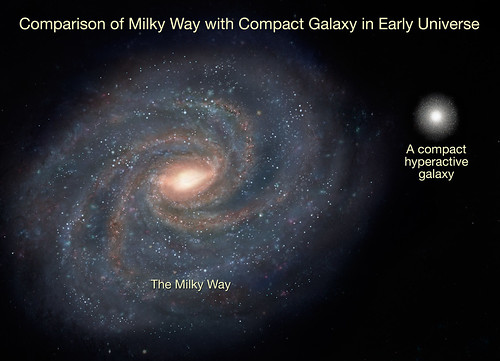Speeding Stars in Space

Can’t drive 55? Try 1 million MPH:
Stars in a distant galaxy move at stunning speeds — greater than 1 million mph, astronomers have revealed.
These hyperactive stars move at about twice the speed of our sun through the Milky Way, because their host galaxy is very massive, yet strangely compact. The scene, which has theorists baffled, is 11 billion light-years away. It is the first time motions of individual stars have been measured in a galaxy so distant.
While the stars’ swiftness is notable, stars in other galaxies have been observed to travel at similarly high speeds. In those situations, it was usually because they were interlopers from outside, or circling close to a black hole.
But in this case, the stars’ high velocities help astronomers confirm that the galaxy they belong to really is as massive as earlier data suggested.
Bizarre, indeed
The compact nature of this and similar galaxies in the faraway early universe is puzzling to scientists, who don’t yet understand why some young, massive galaxies are about five times smaller than their counterparts today.
"A lot of people were thinking we had overestimated these masses in the past," said Yale University astronomer Pieter van Dokkum, leader of the new study. "But this confirms they are extremely massive for their size. These galaxies are indeed as bizarre as we thought they were."
Scientists used the new velocity measurements, conducted with the Gemini South telescope in Chile and the Hubble Space Telescope, to test the mass of a galaxy identified as 1255-0. The same way that the sun’s gravity determines the orbiting speed of the Earth, the galaxy’s gravity, and thus its mass, determines the velocities of the stars inside it.
That’s awesome. Check the NASA site for details.
Astronomers confess that it is a difficult riddle to explain how such compact, massive galaxies form, and why they are not seen in the current, local universe. “One possibility is that we are looking at what will eventually be the dense central region of a very large galaxy,” explains team member Marijn Franx of Leiden University in the Netherlands. “The centers of big galaxies may have formed first, presumably together with the giant black holes that we know exist in today’s large galaxies that we see nearby.”
To witness the formation of these extreme galaxies astronomers plan to observe galaxies even further back in time in great detail. By using the Wide Field Camera 3, which was recently installed on the Hubble Space Telescope, such objects should be detectable. “The ancestors of these extreme galaxies should have quite spectacular properties as they probably formed a huge amount of stars, in addition to a massive black hole, in a relatively short amount of time,” says van Dokkum.
This research follows recent studies revealing that the oldest, most luminous galaxies in the early universe are very compact yet surprisingly have stellar masses similar to those of present-day elliptical galaxies. The most massive galaxies we see in the local universe (where we don’t look back in time significantly) which have a mass similar to 1255-0 are typically five times larger than a young compact galaxy. How galaxies grew so much in the past 10 billion years is an active area of research, and understanding the dynamics in these young compact galaxies is a key piece of evidence in eventually solving this puzzle.
Looking back in time, 10 billions ago. A million mile per hours. This astronomy stuff can be so mind-boggling.